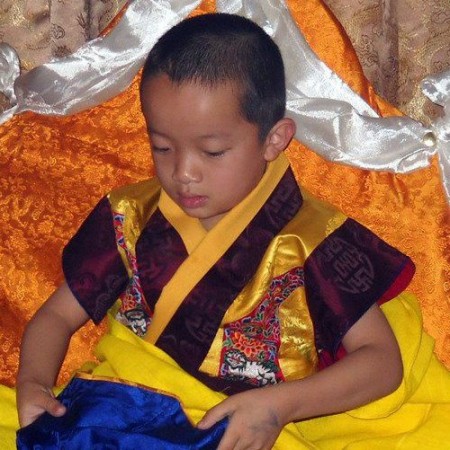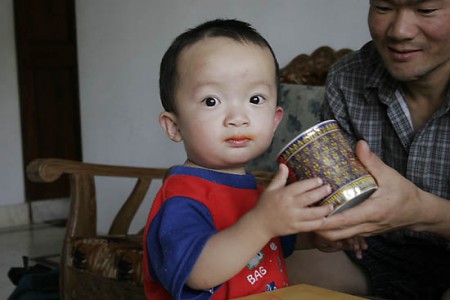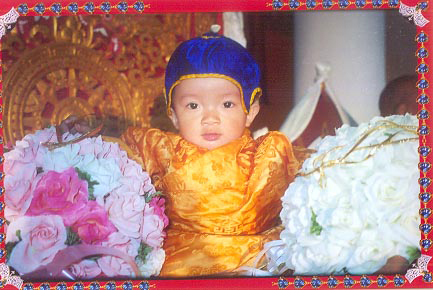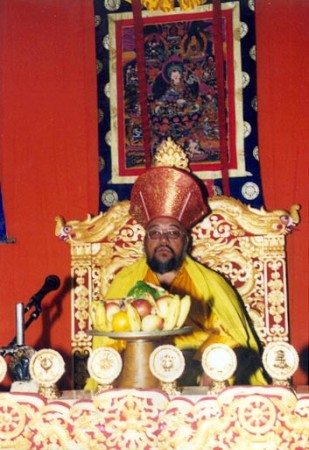Indra Adhikari September 26, 2012
The tenth Shabdrung’s picture has appeared in public almost after seven years. The picture has come to the public through a facebook post this week. Nothing has been mentioned about when and where was the picture taken. The boy had vanished under government order in 2005.
This new boy was regarded as Shadrung soon after the ‘planned’ murder of ninth Shabdrung Jigme Ngawang Namgyal in 5 April 2003.
Pema Namgyal, revered as new incarnate Shabdrung was born to Tashi Dawa and Weshi Wangmo on 2 November 2003.
He was first identified and put forward by Urgen Thinley, recognised as Karmapa by His Holiness Dalai Lama.
The Rinpoche was secretly transferred to Bodh Gaya in December 2004 at the tender age of eighteen months because of a perceived threat to his life, allegedly from vested political interests in Bhutan.
Because, a committee in Bhutan has to verify his eligibility of being incarnate, it was a challenge to get him recognition. Until ninth Shabdrung, the external forces including top Tibetan Buddhists saints used to recognise Shabdrung. Royals in Bhutan have perceived threat from Shabdrung ever since monarchy came to power. The palace forces ‘allegedly’ killed all the Shabdrung incarnates of post-Bhutan monarchy era.
The ninth Shabdrung lived in exile for all his life yet he was killed finally. Family, friends, devotees and relatives feared that the new Shabdrung might face the same fate. As a temporal leader, the Rinpoche exercises great influence on citizens of Bhutan after many years of exile.
The young boy was taken to Bhutan along with the secretary of Delhi-based Shabdrung Rinpoche Charitable Trust, Lama Sonam Dorji on October 15. Though he had planned to return Bodh Gaya by 23 October after the recognition committee completes the process, Shabdrung and Dorji never returned.
Shabdrung and Bhutanese royals have struggled since a century over who should have authority to rule the Bhutanese people. Shabdrungs regard their power was snatched away by Wangchuk with the support of the British India authorities.
In one of his interviews in 2005, the ninth Shabdrung Rimpoche had said, he does not want to recollect the past. Neither is he prepared to return to his country at this juncture. He had said, “It is dangerous. You can’t speak about the system. It is worse than terror, so it is extremely dangerous.”
The ninth Shabdrung also lived in exile since the age of 5. Earlier, he lived in Manali in Himachal Pradesh, where he was educated and later moved to a monastery in Sakyong, 25 kilometres from Kalimpong.
He had repeatedly expressed threat to his life from Bhutanese authorities as the Druk regime is alleged to have murdered the earlier two reincarnations.
It has not been clear about the relation between the Shabdrung’s institution and the monarchy in Bhutan. The royal family has been making all efforts to subside the emotional powers of Shabdrung reining among Bhutanese population. At the same time, indoctrinating the new Shabdrung that monarchy is the ultimate power of the kingdom, since his childhood, Bhutanese monarchy is secure its position and sublimate the strength of Shabdrung.
It takes time to see how the young Rimpoche reacts to the authority of Wangchuks and what fate will he have.
Also read an article on Shabdrung by Lt Rongthong Kunley Dorji
My Understanding of Shabdrung
The unexpected sad demise of H.H Shabdrung Jigme Ngwang Namgyel Rimpoche on 5th April 2003 made shocking news , with the media propounding a conspiracy theory of his death.
Let me bring to your knowledge the history of Shabdrung and his reincarnations in brief. The first Shabdrung Ngwang Namgyel was born in 1593 at Ralung in Tibet. He came to Bhutan in 1616. At that time Bhutan was known as “Lho-Mon” as it lies in south of Tibet . Buddhism spread to Bhutan from Tibet. “Bhutan” came to be known as such during British India
By 1637, H. H. Shabdrung Ngwang Namgyel Rimpoche had unified the country and named it Druk Gyalkhap and hence its people came to be known as the Drukpas. He also established Drukpa Kargyupa as the state religion. During his time, the Nyingmapa tradition was equally respected and his root guru was from the Nyingmapa sect. He instituted the “Choe-Sid system” or the dual system of governance, where the Je Khenpo was in-charge of religious matters as the head of the Drukpa Kargyupa sect of Mahayana Buddhism in Bhutan, while the Desid (Deb Raja) was in-charge of state affairs. The Desid was nominated by the Punakha Dzongpon, the Thimphu Dzongpon, the Wangdi Phodrang Dzongpon, the Zhung Droneyer, the Zhung Kalyeon, the Zhung Dongsapa, the Tongsa Penlop, the Paro Penlop, the Daga Penlop and the Zhung Draktshang. The Je Khenpo on the other hand, was appointed from amongst the Dorji Lopen, the Yangbi Lopen, the Drabi Lopen, the Tshenyi Lopen and the Dratshang Umzey. The Dorji Lopen was usually considered the first choice for the post of the Je Khenpo, since he usually was the most learned among the group. Both these positions had a fixed tenure of three years, but it wasn’t uncommon for their tenures to be extended. Desid Umzey Tenzin Drugyel (1651-1655) was the first Desid. Pekar Jungney was the first Je Khenpo.
Until the 7th Desid, normally someone from amongst the religious clergy was chosen for the post. Sometimes the heart and the speech reincarnate of the Shabdrung have also been selected as the Desid. Occasionally, capable people from outside the clergy were also chosen. Sometimes powerful people occupied the post by manipulation or force.
In 1661, Ngwang Jigme Drakpa, the heart reincarnate (Thugtrul) of the Shabdrung was recognized as the first reincarnate of the Shabdrung by the Lhengey Zhungtshok (Central cabinet). The speech reincarnate (Sungtrul) was also recognized but the throne of First Shabdrung is instituted to Thugtrul (Heart Incarnate).
In 1907, Ugyen Wangchuck became Bhutan’s first king. The 7th reincarnate of the Shabdrung, Jigme Dorji had been born in 1905 at Shar Dirang, Bomdala, Tawang District, of present day Arunanchal Pradesh. Incidentally, the second king, Jigme Wangchuck, was also born in 1905. Ugyen Wangchuck and central Monastic body invited the Shabdrung to Punakha when he was six years old (1911) and ceremoniously enthroned him. The Shabdrung’s family also accompanied him to the Talo Palace and the Punakha Dzong. His first cousin Ashi Dorji Wangmo married Lopen Sangay Tenzin. Four boys and three girls were born out of this matrimony, App Ugyen Dorji being the eldest son (present four Queen’s father).
The Sungtrul Chogley held the post of the 63rd Deb Raja (last Deb Raja) from 1903-1906. During his tenure as Deb Raja, since some of his activities violated the monastic code of conduct, the government and central monastic body passed a resolution that the Sungtrul (speech incarnate) would not be acknowledged in future. Sungtrul Chogyel expired after few years and was born as a reincarnate to Ashi Dorji Wangmo’s son. Ashi Dorji Wangmo and her family requested the then Shabdrung to recognize the Sungtrul but the Shabdrung declined to do so as the institution of Sungtrul had been abolished by the government and the central monastic body. This rejection by the Shabdrung created a rift in the family.
The Shabdrung’s brother, Chhoki Gyeltshen went to India for the pilgrimage in 1929-30. The rumours of Chhoki Gyeltshen meeting with Mahatma Gandhi during his pilgrimage with the intention of garnering support for the Shabdrung from British India and influential Indians politician in order to challenge the Monarchy spread over the country. We don’t now if he met Mahatma Gandhi, but when he arrived back, the then Paro Penlop Tshering Penjore, Gangtey Tulku reported these rumours as the truth to king Jigme Wangchuck. He promptly ordered Lame Gonpa Dasho Phuentsho Wangdi to investigate the matter and dispatched him to Talo with a five-hundred-strong army. Even thought they found out that Shabdrung was unaware of the Choki Gyeltshen’s story, the king asked the central monastic body and senior government officials to vouch for the Shabdung in writing. The central monastic body convened a meeting to sign the statement, but the Dorji Lopen Samten Jamtsho (alias Dung Bava) walked away from the meeting and hence sealed the fate of the Shabdrung’s life in 1931. The king’s plot became obvious, as Samten Jamtsho later went on to become the Je Khenpo as a favour for his role in implicating the Shabdrung. He held the post for more than 20 years completely violative of the traditional three-year tenure system. I also met Chhoki Gyeltshen in 1959 at Dechencholing Palace, who was then having very good relations with the third king, Jigme Dorji Wangchuck.
Due to prevailing situation and fear, the Sungtrul and his family fled to Kalimpong. They stayed in Pedung for more than 20 years. The Sungtrul befriended and developed a special rapport with Gongzim Sonam Tobgay Dorji (The then Bhutan Representative in India).
In 1939, the 8th reincarnate of the Shabdrung was born in Manla, Jangphu.village, Tashigang (Eastern Bhutan). Incidentally I was also born in 1939. Many auspicious signs were visible when he was born and the news of his birth spread across the country and disciples and devotees from across the country came to receive his blessings. Lopen Melam Rabzang offered the title of Shabdrung Ngwang Namgyel Jigme Tenzin to the young boy. The then Tashigang Dzongpon, Thinley Tobgay (Dopola), who was a very powerful warlord in Eastern Bhutan took special care of the Shabdrung and kept him under his protection.
The overall scheme to get rid of the Shabdrung and install the Sungtrul as the Shabdrung unfolded when in early 1952, the second king “granted” the “request” of Gongzim Sonam Tobgay Dorji to allow the Sungtrul to return to his former place. When the King was at Kunga Rabten Palace in Tongsa (the then winter Palace), the Sungtrul and his family were staying at the Tak-tse Chakhar Lakhang, Tongsa. But his plan could not be realized as King Jigme Wangchuck passed away in February of 1952. A month later, Sungtrul too passed away.
The third king, Jigme Dorji Wangchuck was already married to Gongzim Sonam Tobgay Dorji’s daughter Kezang Chhoden (the present Queen Mother) then was residing at Paro as Paro Penlop. After his father demise, he went to Kunga Rabten Palace and assumed all the responsibilities of his father. The Tashigang Dzongpon went to attend the second King’s funeral at Bumthang. The Dzongpon became suddenly ill after being administered an injection for some “ailment” and died at Bumthang. With his death, the little Shabdrung Jigme Tenzin was left completely unprotected, and met with a similar fate as his previous reincarnate. The third king then reinstated the late Sungtrul Chogyel’s family and even handed over the trusteeship of Sungtrul Gonpa, Sanga Chhokhor, at Paro , when they requested for the same till the sungtrul reincarnation. At present, the Gonpa is under the control of App Ugyen Dorji.
The 9th reincarnate of the Shabdrung, Shabdrung Jigme Ngwang Namgyel was born in Manla, Jangphu, Tashigang, in 1955, to the sister of the 8th Shabdrung. Auspicious signs were visible when he was born and news of his birth spread across the country. The present king Jigme Singye Wangchuck is also born in 1955.
The young Shabdrung’s uncle, Lama Jangchuk Pelzang, fearing that similar fate as that of the previous Shabdrungs would befall the reincarnate, whisked him to Tawang, Arunnachal Pradesh at the tender age of six. Lama Jangchuk Pelzang requested the political officer of Tawang for protection of his nephew. The political officer in turn handed over the matter to Mr. Rustomji, the Chief Secretary of Assam stationed at Shillong. The Shabdrung was handed over to the Government of India by Rustomji and Government of India arranged for him to be kept him at Rewalsar, Mandi, Himachal Pradesh.
He received Buddhist teachings and was also tutored in Hindi and English. In Rewalsar (Tsho Pema), in 1963, he received the ‘Terzye Wang Lung’ from H. H. Chabje Dudjom Jigdral Yeshi Dorjee and who recognized him as the true heart reincarnate of the Shabdrung. He stayed on in Manali, Himalchal Pradesh and also stayed in Delhi, especially during the winter months. Thousands of Bhutanese devotees visited him to receive his blessing in Delhi and Himalchal Pradesh. He also recently setup a monastery at Buddha Gaya and Sakyoung, near Kalimpong.
>From amongst the Sungtrul’s family, I personally happened to know App Ugyen Dorji and Ama Thuji Zam and others in the family from the 1960s. Their eldest son Sangay Nidup is presently Minister for Health & Education. Their eldest daughter Ashi Bidha and her husband Ugyen Dorji (presently the Speaker of National Assembly) were also known to me. Infact, Ugyen Dorji was one of my closest friends and I would be invited for dinner at their house whenever I was in Thimphu. The second, third, fourth and the fifth daughters are the present queens. Ashi Dorji Wangmo (pet name Aungo) is the present eldest Queen. I know her from the early 1970s.
In 1985, the 9th Shabdrung visited Samdrup Jongkhar (Eastern Bhutan) along with his sister. Even though every Bhutanese knows that the Shabdrung is banned from entering Bhutan, his disciples clandestinely sheltered him in their house while he gave audience to thousands of devotees.
After three days, I went to receive the Shabdrung’s blessings and warned him of the danger to his life from the Royal Government, particularly considering that the Royal government had a hand in the fate of the previous Shabdrungs. Incidentally this was our first meeting. At one ‘clock, exactly after seven hour of the Shabdrung’s departure, Royal Bhutan Army and Police personnel, lead by Major Lafu of the Royal Bhutan Army and Captain Kipchu of the Royal Bhutan Police, arrived at Samdrup Jongkhar. The Dzongda, Thrimpon, senior police officials, businessman and other people who had been to see the Shabdrung were taken to Thimphu and kept under house arrest for 15 days. They were later released with on the condition that this incident was not to be repeated again. After their release, they made many allegations against me that I was the one who had reported to the government, but I believed in myself and that I actually saved Rimpoche. If I had not warned Rimpoche, his fate would have been certainly sealed. I was also interrogated and my statement recorded in audio cassettes. I questioned the interrogator about our so-called “wrongs” when the entire senior officials and public were also involved.
In 1991, the king was in Samdrup Jongkhar on a Dzongkhag tour. About eight thousand Sharchops, Zonal Administrator Dasho Jigme Thinly, government officials, Thrimpons, Gups, Chimis and the Dzongdas appointed me to represent them and speak on their behalf. I had prepared my speech after consulting all the people concerned. During my speech, when I began taking about the role of the first Shabdrung in unifying Bhutan, I was interrupted by king who said that I need not explain history to the public. However, I didn’t heed the interruption and completed my speech. But the king was so worked up about my reference to the Shabdrung, that he did not hear my mention of the contribution of the institution of the monarchy in strengthening Bhutan and ushering it into the future.
Some people with vested interested have fed concocted tales about me to King and the royal family. The king’s unwise judgment landed me behind bars for fifty days where I was mercilessly tortured for no fault of mine. After my release, I unwillingly fled my motherland for Nepal in order to save my life.
>From Nepal, I submitted a memorandum on the behalf of Bhutanese public recorded in the audio cassettes to King through Chief Justice Sonam Tobgay and waited for three years for a positive answer. But King didn’t take serious note of my memorandum and thus, I formed the Druk National Congress on 16 June, 1994 with the support of Bhutanese Public for the establishment of democracy and human Rights in Bhutan. Our principal aim was to establish democracy and preserve the rich cultural heritage, religion and traditions of Bhutan.
In 1997, I was elected the Chairperson of The United Front for Democracy in Bhutan to lead the democracy movement. I unsuccessfully tried to get an audience with the Shabdrung Rimpoche whenever I was in Delhi. In 1997, April, I was arrested in Delhi by the Government of India at the behest of the Royal Government of Bhutan. During my incarceration, Thinly Penjore and Cheku Drukpa met the Shabdrung and I received his blessing through them.
On the 12th of June 1998, I was released on bail. After one month, I along with my family and some DNC members had an opportunity to get an audience with Rimpoche at his office. I had an hour long separate discussion with him on the prevailing situation in Bhutan. I explained to him the Druk National Congress’ stand on the issue. I requested Rimpoche to preserve the institution of the Shabdrung as the Supreme Spiritual Leader of Bhutan within the framework of the proposed constitution. He agreed and gave his blessings.
After one month, I again had an opportunity to meet with him and request for his blessings, where I reiterated the same stand. Later when I requested for the Shabdrung’s audience I was not given appointment. I don’t know what Thinley Penjore & Co must have told Rimpoche to evoke such a reaction from him.
The Indo Bhutan Friendship Society (IBFS) was formed in 1999 to consolidate the longstanding friendly ties between the people of India and Bhutan. Mr. Satya Prakash Malaviya, the President of IBFS and Prof. Anand Kumar sought an audience with the Shabdrung Rimpoche who gave them an appointment. Later on appointment was cancelled. After that IBFS officials didn’t seek any further appointments with Rimpoche. We however hold him in very high respect and regard even though our relation was stained for reasons we have never clearly understood.
On the 13th of November, 2002, the Kathmandu Post of Nepal reported an interview of the Shabdrung where he stated that “the refugees (Bhutanese) had not been treated as human beings. They must be given due respect. Bhutan has done no justice to them. It should be practical. Mere talks cannot resolve the refugee problem”. Having passed such remarks and also having remarked on human rights violations in Bhutan, Thinly Penjore, Khila and other Lhosampa leaders have exaggerated on the point to gain political advantage from this.
On 1st March, 2003, Thinley Penjore gave a press release that there are about 2700 unregistered Sharchop refugees in the refugee camps in Nepal. We had to quickly counter this false claim because the actual figure was between 30-40 – all political asylum seekers.
Again on 4th March, 2003, “2700 Sharchops requesting Rimpoche to lead his flock for repatriation” appeared in the Himalayan Times daily. Rimpoche is quoted as saying “I myself am living a life of an exile in India for three decades now despite my wishes, and as such, am virtually helpless at this stage.”
After one month, Rimpoche passed away on the 5th of April, 2003 at CMS, hospital, Vellore, India.
Then I came to know through various news papers of the Royal Government’s hand in the Shabdrung’s death, as alleged by Thinly Penjore. The retaliatory remarks on Kuenselonline.com’s editorial “conspiracy theory” questioning the credibility of Shabdrung incarnate and “throat cancer” being the cause of his death, and Rimpoche’s secretary, Sonam Dorji’s reiteration of the Kuensel remarks is a point for serious thought. When the entire Bhutanese public knows him to be the true heart reincarnate of the Shabdrung and receives his blessings, the credibility question doesn’t arise at all. In 1988, late prime minister of India, Rajeev Gandhi arranged for the king to meet the 9th Shabdrung Jigme Nagwang Namgyel face to face at New Delhi. Why would the Prime Minister have arranged the meeting at all if he was not the Shabdrung?
The cause of his death is debatable and we will soon get the answer. “the Almighty has his own way of giving Justice!”
The Indo-Bhutan Friendship Society and the Druk National Congress held a Seminar on the 13th of April, 2003 at the Constitutional Club, New Delhi. The members observed a two minute silence in the Shabdrung’s memory and prayed for the early reincarnation of Rimpoche and blessings for all sentient beings. It is time to undo all the past events and pave the way for the new era of prosperity and happiness by reserving the special privileges for Shabdrung’s reincarnatation, since the 1st Shabdrung was the founder and preserver of our country. I think that the crucial time has arrived for the people and the Royal Government of Bhutan to give serious thought to this issue and to the future of Bhutan.
Source: http://www.ipajournal.com/2012/09/26/is-new-shabdrung-threat-to-bhutanese-royals/




No comments yet... Be the first to leave a reply!